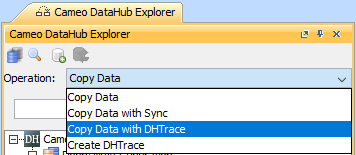On this page
The DataHub Operation drop-down list has options for copying data without or with synchronization, with DHTrace, and creating DHTrace as follows
The DataHub Operation drop-down list.
Copy Data
This option only copies data. It does not allow synchronization.
Copy Data with Sync
This DataHub operation mode allows copying data with synchronization. You can perform synchronization between source and target nodes, either unidirectional or bidirectional, in this mode.
Copy Data with DHTrace
This DataHub operation mode copies data and also includes a trace link between the source and target elements. When a node containing a trace link changes, that trace link is marked Suspect.
Trace links or DHTrace links can exist between text-based Requirements and models or elements that define them, like use-cases, system artifacts, documents and other Requirement objects.
When the nodes being traced are modified, deleted, or moved, you can right-click a node in either the MagicDraw Containment tree or DataHub Explorer and select Check DHTrace Changes Recursively. Choosing this option opens up the DHTrace Summary dialog which lists all the Suspect links in the system. You can choose to clear the Suspect trace through the DHTrace Summary dialog or you can leave them. In this case, the Requirement is validated.
Create DHTrace (with OSLC links)
This DataHub operation mode creates a DHTrace link between the source and target items. A trace link can exist between two requirement objects or between requirements and their model elements such as a use-case. As in the previous operation mode, whenever the source or target nodes are moved, modified, or deleted, will result in the trace link becoming Suspect.
You can then right-click the node in MagicDraw containment tree or DataHub Explorer and choose Check DHTrace Changes Recursively. The DHTrace Summary dialog will open allowing you to clear the trace links which have acquired a suspect status, thus validating the state of the requirement and the linked UML element.
Creating OSLC links (through the Create DHTrace operation)
Note
In the 19.0 and later versions, the Create OSLC link operation is not displayed and is used through the Create DHTrace operation instead from the Operation drop-down list in Cameo DataHub Explorer.
OSLC links can be created when you open an IBM® Rational® DOORS® Next Generation Data Source in DataHub. You can create OSLC links from IBM® Rational® DOORS® Next Generation artifacts repository by using the Create DHTrace operation from the Operation drop-down list in Cameo DataHub Explorer.
Typically, an OSLC link is a relation between two lifecycle artifacts. Relationships are modeled with two types of properties: link property and backlink property. The following relations have properties listed in the table below
| Relation | Link property | Backlink property |
| implementation | oslc.implementedBy | |
| constrain | oslc.constrains | oslc.constrainedBy |
| elaborate | oslc.elaborates | oslc.elaboratedBy |
| satisfy | oslc.satisfies | oslc.satisfiedBy |
| affect | oslc.affectedBy | |
| specify | oslc.specifies | oslc.specifiedBy |
| track | oslc.trackedBy | |
| decompose | oslc.decomposes | oslc.decomposedBy |
| validate | oslc.validatedBy |
